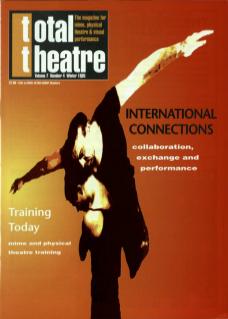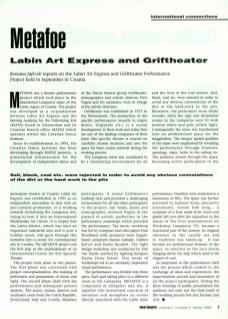Metafoe was a theatre performance project which took place in the abandoned Lamparna mine of the Labin region of Croatia. The project was developed as a co-production between Labin Art Express and the Moving Academy for the Performing Arts (MAPA) based in Amsterdam and its Croatian branch office MAPAZ which operates within the Croatian Dance Institute.
Since its establishment in 1993, the Croatian Dance Institute has been developing, through MAPAZ projects, a professional infrastructure for the development of independent dance and movement theatre in Croatia. Labin Art Express was established in 1991 as an independent association to deal with art and cultural promotion. It is working towards revitalising the Lamparna site, trying to turn it into an International Multimedia Art Centre. It is hoped that the Labin district, which was once an important industrial area and is now a holiday resort, will grow through this initiative into a centre for contemporary arts in Croatia. The Metafoe project was the first step in the establishment of an International Centre for Site Specific Theatre.
The project took place in two phases. The first phase was concerned with project conceptualisation, the training of performers, and preparation of music and light. The second phase dealt with the performance and subsequent project analysis. The actors, mimes, dancers and musicians came from the Czech Republic, Switzerland, Italy and Croatia. Members of the Dutch theatre group Griftheater, mimographer and artistic director Frits Vogels and his assistants, were in charge of the artistic direction.
Griftheater was established in 1975 in the Netherlands. The production of site-specific performances (usually in empty mines, shipyards, etc) is a recent development in their work and today they are one of the leading companies of their kind. Site-specific theatre is created on carefully chosen locations and uses the space for basic source material during the working process.
The Lamparna mine was considered to be a stimulating environment for all participants. It suited Griftheater's working style and provided a challenging environment for all the other participants in the project. Jan Taske, mime and mimographer, assisted Vogels in the pursuit of artistic perfection in the performance workshops which preceded the performance. The music workshop was led by composer and cello-player Paul Stouthmer with assistance from Zagrebbased composers Stanko Jusbasić, Dalibor Bulvić and Darko Rundek. The light design workshop was conducted by Erik van Raalte assisted by lighting designer Rijeka Denu Sesnić. Five weeks of workshops led to an extremely impressive visual performance.
The performance was divided into three parts. Each part taking place in a different room in the Lamparna. Metafoe is a compound of metaphor and foe; it signifies the intentional rejection of narration and metaphors on events directly associated with the Labin mine and the lives of the coal miners. Soil, black, coal, etc were rejected in order to avoid any obvious connotations of the dirt or the hard-work in the pits. Moreover, the performers wore white overalls, while the ugly and devastated rooms in the Lamparna were lit with intense white and pale yellow light. Consequently the mine was transformed into an aestheticised space for the imagination. The unique spatial qualities of the mine were emphasised by revealing the performance through windows, openings, stairs, holes in the ceiling, etc. The audience moved through the space, becoming active participants in the performance. Numbers were restricted to a maximum of fifty. The space was further activated by hammer kicks, percussive movements, Istrian folk song... A sculpture of a boat made from wood and plastic left over after the exposition in the mines of The First International Art Workshop Lamparna '93, became a functional part of the scenery. Its original reference to the nearby sea and to tradition was taken-up. It has become an architectural element of the space, as relevant as the iron hooks hanging above the ship which used to lift cargoes of coal.
As important as the performance itself was the process which created it, the exchange of ideas and experiences, the improvisation process and association of all the project participants. During the three evenings of public presentation the audience not only saw the final result of the working process but also became part of it.

